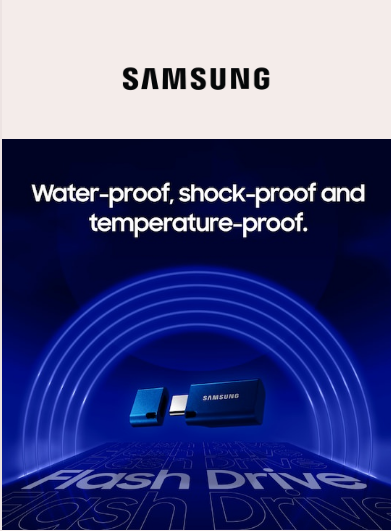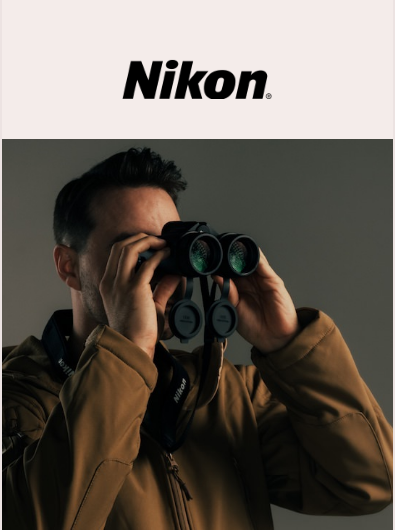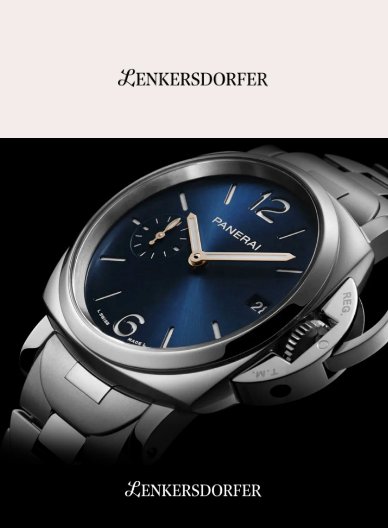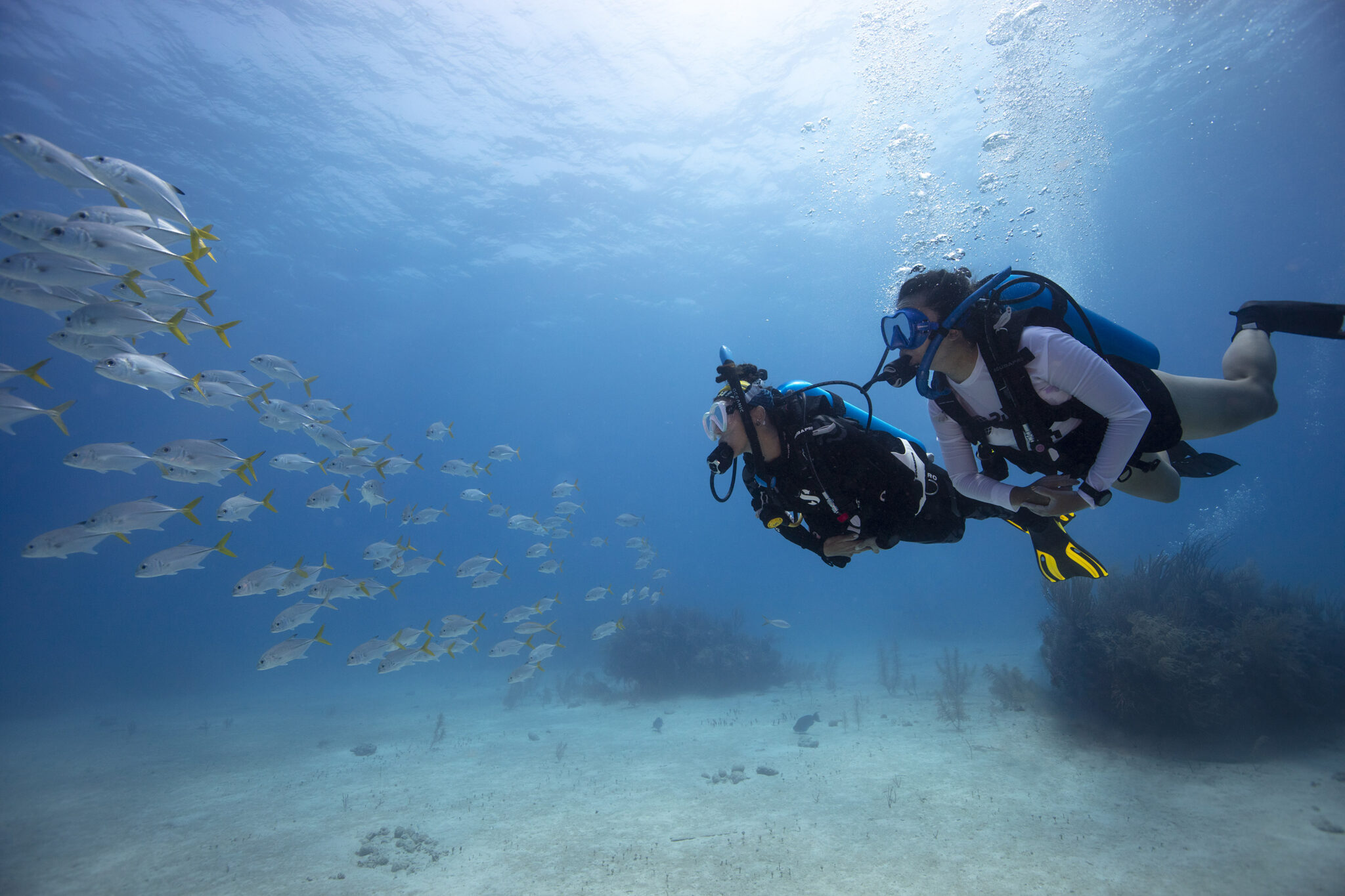
Diving – a guide from A to Z
What is diving? In the simplest terms, scuba diving is being underwater on what is known as a “dive”. stopped breathing (freediving) or staying underwater with appropriate equipment (scuba diving). Diving can be done for a variety of reasons and purposes, reaching for techniques appropriate to the situation and the diver’s skills. What is scuba diving and what are its types? How to start diving, who can dive and what are the contraindications to diving? What do beginners and advanced divers get from diving schools and courses? Find the answers to these and many other questions below!
What is scuba diving and what is its history?
Diving has accompanied man since the dawn of time. Thousands of years ago, people dived primarily for food, but also in search of “treasure” and for military purposes. At the time, people dived primarily on a held breath, but also with cane stalks in their mouths – the other end of the cane protruded above the surface of the water and allowed them to take a breath without surfacing (the modern equivalent of this method is snorkeling).
History of diving – where did it start?
The oldest engravings and descriptions of diving date back to the 1st century BC. These include. a bas-relief from 885 B.C. depicts an armed man breathing underwater using equipment resembling modern-day diving cylinders, as well as Aristotle’s record, dated 332 B.C., of a diving bell said to have been used by Alexander the Great during the siege of Tyre.
Discoveries and inventions – the road to safe diving
The goal of the scientists and inventors who were involved in diving became, in the centuries that followed, to develop solutions to increase the time spent underwater. Leonardo da Vinci is considered the author of the first design of a self-contained underwater breathing system and the first diving suit. A breakthrough invention in the field of diving was the first diving system that allowed free movement underwater, designed in 1797 by Karl Heinrich Klingert.
In the 18th and 19th centuries, many innovations were tested simultaneously. In 1823, the Deane brothers patented a firefighter’s helmet to protect firefighters from the effects of smoke inhalation. Soon after, the firefighter’s helmet, at the request of the inventors, was adapted for diving by August Siebie. It is he, incidentally, who is considered the “father of diving.” It’s all due to the complete, enclosed classical diver’s outfit patented in 1837 – made of gas-tight fabric, with heavy boots and weights (allowing for adjustable buoyancy) and air supply via a rotary pump. The outfit was the first to make it possible to really stay safely underwater for an extended period of time.
Popularization of diving
A surge of interest in diving was noted in the first and then the second half of the 20th century. The popularization of underwater adventures has been most significantly influenced by increasing the safety of divers through the use of modern technological solutions, while gradually reducing the price of suits and the cost of operating breathing apparatuses. Today, millions of people around the world are engaged in diving.
Diving methods – division by technique and equipment selection
Snorkeling, freediving and scuba diving can be accomplished by one of three basic methods: snorkeling, freediving and scuba diving. What are the characteristics of these methods?Snorkeling – amateur diving for everyone
Snorkeling is the simplest form of diving, involving floating or swimming just below the surface of the water, with simple equipment that allows you to admire the underwater world without having to surface for air.
The basic equipment for snorkeling is called. ABC equipment:
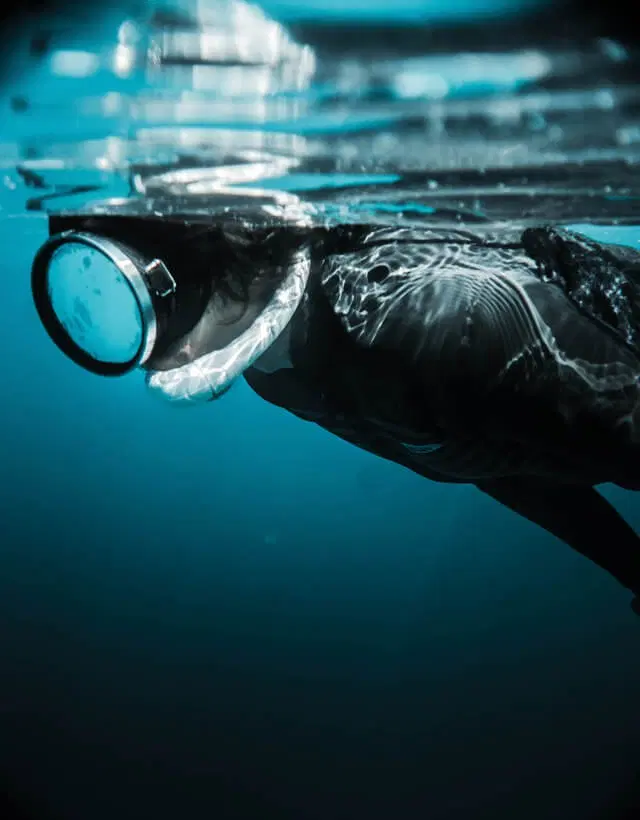
Freediving – diving on held breath
Freediving, translated as free diving, or diving without an aqualung (but not without any equipment at all!) – on held breath, is one of the two basic methods of diving, in which one actually goes underwater to a chosen depth (in snorkeling, the diver merely floats on the water or is just below the surface – he does not go deep). The length of a freediver’s immersion depends on how long they can safely hold their breath underwater. As part of the preparation for the first freediving, it is necessary to conduct breathing exercises and learn the principles of safe immersion and emergence from the water.Freedivers do not use an aqualung that allows them to stay/breathe underwater, but they can:
Scuba diving – scuba diving with aqualung
Scuba diving is equipment diving. A diver practicing scuba diving is equipped with an aqualung, which is equipment that allows him to swim and breathe freely underwater. This is the only diving method that allows you to stay underwater and explore the underwater world continuously for an extended period of time.The basic equipment of a scubadiver is:
Optionally, the scubadiver’s equipment can also include:
Types of diving – a division by the purpose of diving
You can dive for different reasons and purposes, and the division into recreational diving (rec diving) and technical/sports diving (tec diving) is definitely not exhaustive.
Here are the most popular types of diving and the techniques used in them:
Amateur recreational diving – snorkeling
This is the type of diving that is practiced by the largest number of people around the world. Snorkeling can be practiced with almost no restrictions (age and health) and without any major preparation – just fitting a mask and mastering the skills of breathing with a tube / snorkel. Snorkeling is hugely popular among tourists visiting the country, including. Egypt, Croatia, Greece or Italy.
The most beautiful snorkeling spots include:
Recreational diving – freediving and scuba diving
Recreational diving can be practiced in many different ways, without or with equipment, by both beginners and advanced divers of varying degrees. Unlike amateur snorkeling – recreational diving practiced by freediving and scuba diving methods should always be preceded by training appropriate to the technique. Regardless of the method chosen and the type of equipment or aqualung (or lack thereof) – the purpose of recreational diving is to relax and unwind, a way to meditate (especially in the case of freediving) and to enjoy admiring the underwater world and overcoming one’s own barriers.
Freediving and scuba diving can be practiced both in natural bodies of water and in special pools – simulators of diving conditions. The contractual limit for recreational diving is 40 meters deep.
Amateur sport diving – freediving and scuba diving
Sport diving can be a form of recreation at the same time. What distinguishes sports diving from recreational diving is, among other things. frequency and regularity of dives (recreational diving is usually occasional). The goal of those treating diving as a sport is also different – diving in this case is supposed to be a kind of physical activity, during which certain activities are performed and all muscle parts are engaged. Divers also strive to improve their performance, to increase their mobility and efficiency, their diving speed or their speed of movement underwater.
Amateur sport diving can be practiced both in natural bodies of water and in special pools – simulators of diving conditions.
Technical diving – freediving and scuba diving
Technical diving (also referred to as professional or sport diving) is dedicated only to experienced divers with extensive knowledge and highly rated skills, as well as the right equipment – definitely more advanced than in recreational diving. This is a dive that requires divers to be in good physical condition and to be free of any contraindications to this activity (technical divers must undergo regular medical check-ups to confirm very good health).
Technical diving can be quite a strain and challenge to the body, as it definitely exceeds recreational limits – regarding the depth of immersion (divers technically exceed the 40m depth limit) and/or the length of time they stay underwater. Technical diving can be performed at different depths, with or without changing decompression gases, using multiple breathing mixtures during a single dive. Therefore, technical diving involves more risk than recreational diving.
The goal of technical diving is to improve one’s skills, improve one’s performance and acquire more degrees, among others. by exceeding standard time and depth limits, but always with safety rules. It is imperative to learn technical diving under the guidance of an experienced instructor, such as specialized courses provided by tec diving organizations TDI, IANTD or PADI/DSAT.
The most important rule of technical diving is to plan your dive precisely, and then dive according to that plan. The so-called. Run Time details the entire course of a dive: from submergence to ascent, specifying the points where the diver should be at any given time. Run Time planning should involve optimizing the dive in all respects.
Wreck diving – scuba diving
Wreck diving is diving that aims to explore sunken wrecks and other objects that are the result of human activity (as opposed to exploring underwater flora and fauna), such as sunken oil rigs or sunken cities. Penetration of submerged objects is carried out by equipment diving, or scuba diving.
Cave diving – scuba diving
Cave diving is diving that aims to explore underwater caves, passageways and adits. Cave diving can be carried out at various depths, but most often involves the inability to ascend vertically to the surface, so it requires proper training and skills (rather exceeding rec diving skills), very good physical fitness and mental toughness. Cave diving is done with equipment, that is, under the scuba diving method.
Commercial and professional diving
We speak of commercial and professional diving when it is directly related to work. Commercial diving is performed by the so-called. professional diver, i.e., a person who has the appropriate psycho-physical qualities and the necessary skills, as well as the qualifications / authorizations confirming them.
A professional diver must have a certificate of completion of a dedicated course, which includes. Class information: a Class III diploma authorizes professional diving at depths of up to 20m, a Class II diploma authorizes professional diving at depths of up to 50m, and a Class III diploma authorizes professional deep-sea diving and underwater work at depths of more than 50m. The health requirements for a professional diver are strictly defined by the Ministry of Health Regulation on Health Conditions for Underwater Work.
Professional divers include:
Diving equipment
Scuba diving equipment is a very broad category in which new products regularly appear. In the most general terms, diving equipment can be divided into ABC equipment (which is the only equipment of a person diving on held breath, using the freediving method) and other diving equipment / air equipment (which is more or less extensive and advanced equipment of the scuba diver) and additional accessories / auxiliary equipment.
ABC equipment: mask, fins, snorkel
ABC equipment is a mask, fins and snorkel, which make snorkeling possible, the only equipment for freedivers and the basic equipment for scubadivers (but not sufficient for diving by this method). ABC equipment is individual equipment, which means that every diver, even a beginner, should have his own set (at selected dive bases it is possible to rent ABC equipment).
Diving mask
An essential piece of equipment for a diver, enabling proper (sharp, clear) and comfortable vision underwater, thanks to the creation of air space in front of the eyes. A properly fitted mask protects the eyes and nose from contact with water and allows the mask to equalize pressure (through the nose). The diving mask includes the following components:
Snorkel
The snorkel allows you to breathe air without having to emerge from the water. This is the piece of equipment that makes snorkeling possible, and is rarely, very rarely or not at all useful in the rest of the diving techniques. The snorkel can be used, for example, when swimming to a fixed dive site or when returning from a dive, especially when there is a long distance to cover in difficult surface conditions (such as at sea, with high waves or strong current). The snorkel includes the following components:
Diving fins
The purpose of the fins is to increase the surface area of the feet and thus maximize our motor capabilities in the water. Flippers allow you to swim quickly and efficiently using only your legs. The construction of fins is relatively simple – each fin consists of: a fin foot (calliope or strap) and a fin feather (which accounts for the propulsive force of the fins, the feathers can vary in size / length and hardness and vary in shape and functionality).
Fins should not only fit the foot, but also be matched to the diver’s skills and condition. Strip fins are used for diving:
Airborne equipment
Airborne equipment is equipment that allows you to stay underwater for extended periods of time. Air equipment consists of three components: a cylinder or set of cylinders, a breathing machine and a buoyancy system (KRW, BCD or wings).
Diving cylinder / diving cylinder set
Diving cylinders are cylindrical containers of a certain capacity (most commonly: 10l, 12l, 15l, 18l), used to collect/store air at an increased pressure of 150-300at (15-30MPa), which we will use underwater. Cylinders can be made of carbon steel (used primarily in cold and fresh water) or alloy steel and aluminum alloys (used primarily in warm and saltwater). Aluminum cylinders are larger and heavier than steel cylinders of the same capacity, but in the water they become lighter than steel cylinders – they have neutral buoyancy (positive or slightly negative). Steel cylinders have negative buoyancy, so they can reduce the load in a diver’s ballast system.
The steel diving cylinder consists of the following components:
An aluminum diving cylinder usually consists of only two components: the cylinder and the valve.
Two, connected to each other by a special design / handle diving cylinders are Twinset. Two-bottle sets are used primarily by technical divers, but also for cave or wreck diving.
Breathing machine
This is one of the most important pieces of diving equipment, crucial to our safety. It is imperative for a diver to know how an automatic breathing apparatus works, to be able to connect it intuitively and correctly to the cylinder, and to operate it confidently in emergency situations as well. The chosen breathing machine should be properly stored and regularly serviced.
The automatic breathing machine consists of the following components:
Displacement system
A diver’s buoyancy system is nothing more than a KRW rescue and compensation vest (BCD, or Buoyancy Control Device). The vest is a must-have piece of equipment for every diver, increasing his safety and making diving more comfortable.
KRW’s task is:
KRW vests are available in a variety of designs, so that, every diver can choose a model that will be optimally suited to his or her size, needs and skills.
Types of KRW:
Support equipment – additional diving equipment and accessories
This is a wide range of different types of equipment and accessories that are designed to make diving easier and improve the diver’s comfort and optimize his safety underwater.
Auxiliary equipment includes, but is not limited to:



